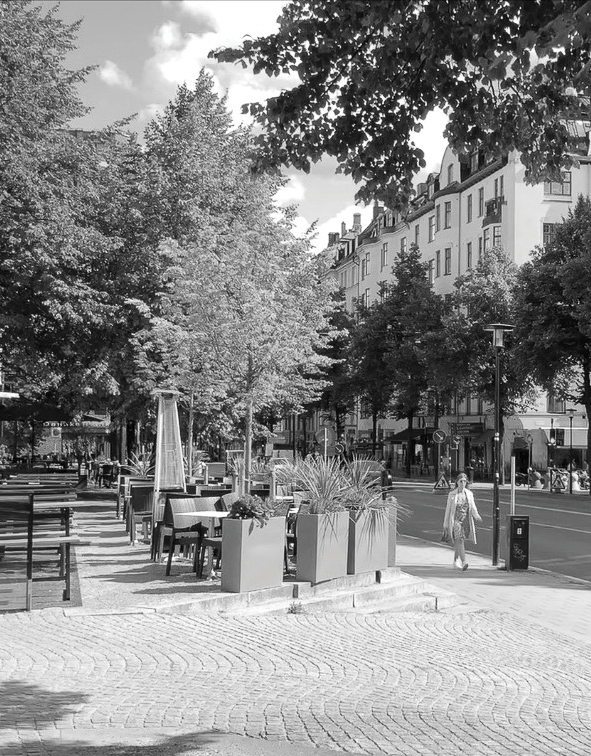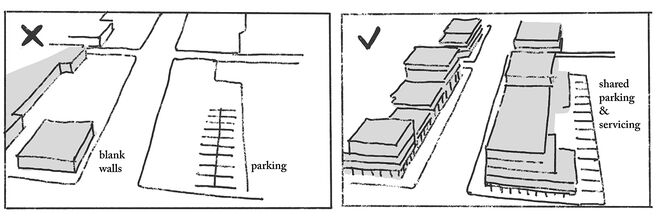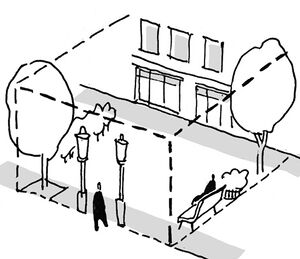8.1. Street As Room
Aus Pattern Language Wiki
(Weitergeleitet von .../Street As Room)
To encourage a Walkable Streetscape and ensure the Street As Center, it is necessary to create proper spatial definition.
Problem-statement: There is a basic psychological need to feel a sense of spatial definition and enclosure. This need exists for pedestrians on streets — but it is often unmet.
Discussion:: Many authors have commented on the difficulty of creating spatial enclosure along walkable streets, and the importance of creating “street walls” that help to do this. For example, Ewing and Handy (2009)1 discuss this problem:
“In an urban setting, enclosure is formed by lining the street or plaza with unbroken building fronts of roughly equal height. The buildings become the ‘walls’ of the outdoor room, the street and sidewalks become the ‘floor’, and if the buildings are roughly equal height, the sky projects as an invisible ceiling. Buildings lined up that way are often referred to as ‘street walls’. Alexander et al. [Pedestrian Street, APL 100] state that the total width of the street, building-to-building, should not exceed the building heights in order to maintain a comfortable feeling of enclosure. Allan Jacobs [in Great Streets] is more lenient in this regard, suggesting that the proportion of building heights to street width should be at least 1:2. Other designers have recommended proportions as high as 3:2 and as low as 1:6 for a sense of enclosure… The expert panel… opined that the required building height to enclose street space varies with context, specifically, between a big city and small town.”
In Ewing and Handy’s own research using visual surveys of expert panelists, they did not find a significant relationship between a precise width-to-height ratio and perceived sense of enclosure. This finding further suggests that there is no single ideal ratio, but rather, a general rule of thumb that varies by context.
Therefore:
When seeking to make a street more attractive to pedestrians, conceive of it as a room, or a series of linked rooms. Assure that there are “walls” in the form of buildings, rows of trees, or other forms of enclosure that are at least half as high as the distance between these walls, but no more than twice as high. Avoid “dead spaces” of large parking lots and other major gaps in the street wall.
Create a sense of enclosure on the long ends of streets with a Terminated Vista of a building or landmark. Establish a relatively uniform street wall (with some defined jogs, setbacks and step-backs) using a Form-Based Code…
¹ See Ewing, R., & Handy, S. (2009). Measuring the unmeasurable: Urban design qualities related to walkability. Journal of Urban design, 14(1), 65-84.8.2.
Mehaffy, M. et al. (2020). STREET AS ROOM (pattern). In A New Pattern Language for Growing Regions. The Dalles: Sustasis Press. Available at https://pattern-language.wiki/.../Street_As_Room
SECTION I:
PATTERNS OF SCALE
1. REGIONAL PATTERNS
Define the large-scale spatial organization…
1.4. 400M THROUGH STREET NETWORK
2. URBAN PATTERNS
Establish essential urban characteristics…
3. STREET PATTERNS
Identify and allocate street types…
4. NEIGHBORHOOD PATTERNS
Define neighborhood-scale elements…
5. SPECIAL USE PATTERNS
Integrate unique urban elements with care…
6. PUBLIC SPACE PATTERNS
Establish the character of the crucial public realm…
7. BLOCK AND PLOT PATTERNS
Lay out the detailed structure of property lines…
8. STREETSCAPE PATTERNS
Configure the street as a welcoming place…
9. BUILDING PATTERNS
Lay out appropriate urban buildings…
10. BUILDING EDGE PATTERNS
Create interior and exterior connectivity…
10.1. INDOOR-OUTDOOR AMBIGUITY
SECTION II:
PATTERNS OF MULTIPLE SCALE
11. GEOMETRIC PATTERNS
Build in coherent geometries at all scales…
11.2. SMALL GROUPS OF ELEMENTS
12. AFFORDANCE PATTERNS
Build in user capacity to shape the environment…
13. RETROFIT PATTERNS
Revitalize and improve existing urban assets …
14. INFORMAL GROWTH PATTERNS
Accommodate “bottom-up” urban growth…
15. CONSTRUCTION PATTERNS
Use the building process to enrich the result…
SECTION III:
PATTERNS OF PROCESS
16. IMPLEMENTATION TOOL PATTERNS
Use tools to achieve successful results…
16.2. ENTITLEMENT STREAMLINING
16.3. NEIGHBORHOOD PLANNING CENTER
17. PROJECT ECONOMICS PATTERNS
Create flows of money that support urban quality…
17.4. ECONOMIES OF PLACE AND DIFFERENTIATION
18. PLACE GOVERNANCE PATTERNS
Processes for making and managing places…
18.3. PUBLIC-PRIVATE PLACE MANAGEMENT
19. AFFORDABILITY PATTERNS
Build in affordability for all incomes…
19.1. INTEGRATED AFFORDABILITY
20. NEW TECHNOLOGY PATTERNS
Integrate new systems without damaging old ones…
20.2. RESPONSIVE TRANSPORTATION NETWORK COMPANY


